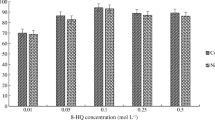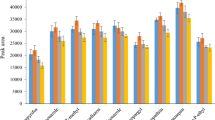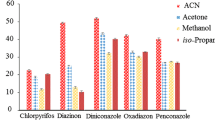Abstract
In the present work, a simple and fast sample pretreatment method based on salt-induced homogenous liquid–liquid microextraction has been proposed for the extraction and preconcentration of some widely used pesticides (diazinon, ametryn, chlorpyrifos, penconazole, oxadiazon, diniconazole, and fenazaquin) from different fruit juice samples prior to gas chromatography-flame ionization detection. Initially, a small volume (microliter level) of an extraction solvent (iso-propanol) is added into an aqueous phase containing the analytes in order to obtain a homogenous solution. Then, a phase separation agent (sodium sulfate) is added into the homogeneous solution. By this action, the extraction solvent releases from the homogenous solution in the form of tiny droplets containing the analytes and collects on the surface of the aqueous phase as a thin film. A home-made device is used to simplify the removal of the collected organic phase. Finally, an aliquot of the collected organic phase is removed and injected into the separation system for analysis. Under the optimum conditions, limits of detection and quantification were obtained at the ranges of 0.22–0.48 and 0.73–1.7 μg L−1, respectively. The enrichment factors and extraction recoveries of the selected pesticides ranged from 410 to 480 and 82 to 96%, respectively. The relative standard deviations were ≤ 7% for intra- (n = 6) and inter-day (n = 4) precisions at a concentration of 10 μg L−1 of each analyte. Finally, the proposed procedure was successfully applied to the analysis of real samples including apple, sour cherry, peach, grape, and orange juices in order to simultaneously determine the seven aforementioned pesticides. The proposed approach is simple, sensitive, rapid, and requires low solvent consumption, which, in the era of green chemistry, represents a significant advantage. This method and the obtained results can contribute in the improvement of food quality as well as monitoring level of pesticide usage in fruit juices.





Similar content being viewed by others
Abbreviations
- EF:
-
Enrichment factor
- ER:
-
Extraction recovery
- FID:
-
Flame ionization detector
- GC:
-
Gas chromatography
- LLE:
-
Liquid–liquid extraction
- LOD:
-
Limit of detection
- LOQ:
-
Limit of quantification
- LR:
-
Linear range
- MS:
-
Mass spectrometry
- RSD:
-
Relative standard deviation
- SPE:
-
Solid phase extraction
References
Albero B, Sánchez-Brunete C, Tadeo JL (2005) Multiresidue determination of pesticides in juice by solid–phase extraction and gas chromatography–mass spectrometry. Talanta 66:917–924
Boonchiangma S, Ngeontae W, Srijaranai S (2012) Determination of six pyrethroid insecticides in fruit juice samples using dispersive liquid–liquid microextraction combined with high performance liquid chromatography. Talanta 88:209–215
Çabuk H, Köktürk M, Ata S (2014) pH–assisted homogeneous liquid–liquid microextraction using dialkylphosphoric acid as an extraction solvent for the determination of chlorophenols in water samples. J Sep Sci 37:1343–1351
Chen PS, Huang SD (2006) Determination of ethoprop, diazinon, disulfoton and fenthion using dynamic hollow fiber–protected liquid–phase microextraction coupled with gas chromatography–mass spectrometry. Talanta 69:669–675
Chen B, Wu FQ, Wu WD, Jin BH, Xie LQ, Feng W, Ouyang G (2016) Determination of 27 pesticides in wine by dispersive liquid–liquid microextraction and gas chromatography–mass spectrometry. Microchem J 126:415–422
Ebrahimpour B, Yamini Y, Esrafili A (2013) Acid–induced homogenous liquid–phase microextraction: application of medium–chain carboxylic acid as extraction phase. J Sep Sci 36:1493–1499
European Commission (2011) Method validation and quality control procedures for pesticide residues analysis in food and feed. Document No SANCO/12495/2011. Retrieved from http://ec.europa.eu/food/plant/protection/pesticides/docs/ qualcontrol_en.pdf (accessed on 11 January 2018)
Farajzadeh MA, Djozan DJ, Khorram P (2012) Development of a new dispersive liquid–liquid microextraction method in a narrow–bore tube for preconcentration of triazole pesticides from aqueous samples. Anal Chim Acta 713:70–78
Farajzadeh MA, Afshar Mogaddam MR, Aghanassab M (2016a) Deep eutectic solvent–based dispersive liquid–liquid microextraction. Anal Methods 8:2576–2583
Farajzadeh MA, Mohebbi A, Feriduni B (2016b) Development of continuous dispersive liquid–liquid microextraction performed in home–made device for extraction and preconcentration of aryloxyphenoxy–propionate herbicides from aqueous samples followed by gas chromatography–flame ionization detection. Anal Chim Acta 920:1–9
Farajzadeh MA, Shahedi Hojaghan A, Afshar Mogaddam MR (2017) Development of heat–induced homogeneous liquid–liquid microextraction for extraction and preconcentration of neonicotinoid insecticides from fruit juice and vegetable samples. Food Anal Methods 10:3738–3746
Frías S, Rodríguez M, Conde J, Pérez-Trujillo J (2003) Optimization of a solid–phase microextraction procedure for the determination of triazines in water with gas chromatography–mass spectrometry detection. J Chromatogr A 1007:127–135
Gonçalves C, Alpendurada MF (2002) Multiresidue method for the simultaneous determination of four groups of pesticides in ground and drinking waters, using solid–phase microextraction–gas chromatography with electron–capture and thermionic specific detection. J Chromatogr A 968:177–190
Hosseini MH, Rezaee M, Mashayekhi HA, Akbarian S, Mizani F, Pourjavid MR (2012) Determination of polycyclic aromatic hydrocarbons in soil samples using flotation–assisted homogeneous liquid–liquid microextraction. J Chromatogr A 1265:52–56
Hyötyläinen T, Riekkola ML (2008) Sorbent–and liquid–phase microextraction techniques and membrane–assisted extraction in combination with gas chromatographic analysis: a review. Anal Chim Acta 614:27–37
Lasarte-Aragonés G, Lucena R, Cárdenas S, Valcárcel M (2015) Use of switchable hydrophilicity solvents for the homogeneous liquid–liquid microextraction of triazine herbicides from environmental water samples. J Sep Sci 38:990–995
Millán S, Sampedro MC, Unceta N, Goicolea MA, Rodríguez E, Barrio RJ (2003) Coupling solid–phase microextraction and high–performance liquid chromatography for direct and sensitive determination of halogenated fungicides in wine. J Chromatogr A 995:135–142
Nieto A, Borrull F, Pocurull E, Marcé RM (2010) Pressurized liquid extraction: a useful technique to extract pharmaceuticals and personal–care products from sewage sludge. Trends Anal Chem 29:752–764
Plotka-Wasylka J, Szczepańska N, Guardia M, Namieśnik J (2015) Miniaturized solid–phase extraction techniques. Trends Anal Chem 73:19–38
Sannino A (2007) Determination of three natural pesticides in processed fruit and vegetables using high–performance liquid chromatography/tandem mass spectrometry. Rapid Commun Mass Spectrom 21:2079–2086
Sharma D, Nagpal A, Pakade YB, Katnoria JK (2010) Analytical methods for estimation of organophosphorus pesticide residues in fruits and vegetables: A review. Talanta 82:1077–1089
Topuz S, Özhan G, Alpertunga B (2005) Simultaneous determination of various pesticides in fruit juices by HPLC–DAD. Food Control 16:87–92
Wang JH, Zhang YB, Whang XL (2006) Determination of multiclass pesticide residues in apple juice by gas chromatography–mass spectrometry with large–volume injection. J Sep Sci 29:2330–2337
Wang Y, Wang Z, Zhang H, Shi Y, Ren R, Zhang H, Yu Y (2011) Application of pneumatic nebulization single drop microextraction for the determination of organophosphorus pesticides by gas chromatography–mass spectrometry. J Sep Sci 34:1880–1885
Wang J, Chow W, Leung D, Chang J (2012) Application of ultra high–performance liquid chromatography and electrospray ionization quadrupole orbitrap high–resolution mass spectrometry for determination of 166 pesticides in fruits and vegetables. J Agric Food Chem 60:12088–12104
Wu C, Liu N, Wu Q, Wang C, Wang Z (2010) Application of ultrasound–assisted surfactant–enhanced emulsification microextraction for the determination of some organophosphorus pesticides in water samples. Anal Chim Acta 679:56–62
Yazdanfar N, Yamini Y, Ghambarian M (2014) Homogeneous liquid–liquid microextraction for determination of organochlorine pesticides in water and fruit samples. Chromatographia 77:329–336
Yogesh B, Dhananjay Kumar T (2010) Development and applications of single–drop microextraction for pesticide residue analysis: a review. J Sep Sci 33:3683–3691
Acknowledgements
Authors are grateful to Research Council of the University of Tabriz for financial support. Also, the authors are grateful to Mr. Ali Akbar Alizadeh Nabil and Dr. Houshang Ghorbanpour for their help.
Funding
Mir Ali Farajzadeh has received research grants from University of Tabriz.
Author information
Authors and Affiliations
Corresponding author
Ethics declarations
Conflict of Interest
Mir Ali Farajzadeh declares that he has no conflict of interest. Ali Mohebbi declares that he has no conflict of interest. Mohammad Reza Afshar Mogaddam declares that he has no conflict of interest. Maryam Davaran declares that she has no conflict of interest. Mahdiyeh Norouzi declares that she has no conflict of interest.
Ethical Approval
This article does not contain any studies with human or animal subjects.
Informed Consent
Informed consent is not applicable in this study.
Rights and permissions
About this article
Cite this article
Farajzadeh, M.A., Mohebbi, A., Mogaddam, M.R.A. et al. Development of Salt-Induced Homogenous Liquid–Liquid Microextraction Based on iso-Propanol/Sodium Sulfate System for Extraction of Some Pesticides in Fruit Juices. Food Anal. Methods 11, 2497–2507 (2018). https://doi.org/10.1007/s12161-018-1238-6
Received:
Accepted:
Published:
Issue Date:
DOI: https://doi.org/10.1007/s12161-018-1238-6




